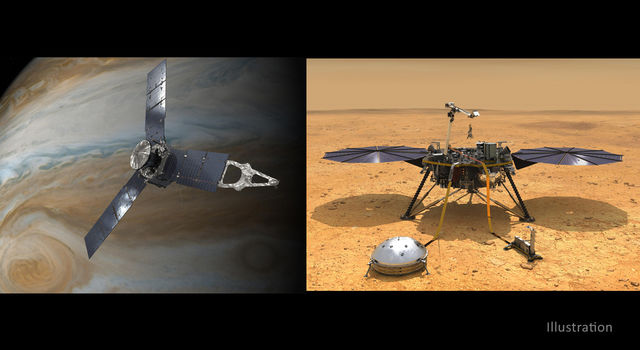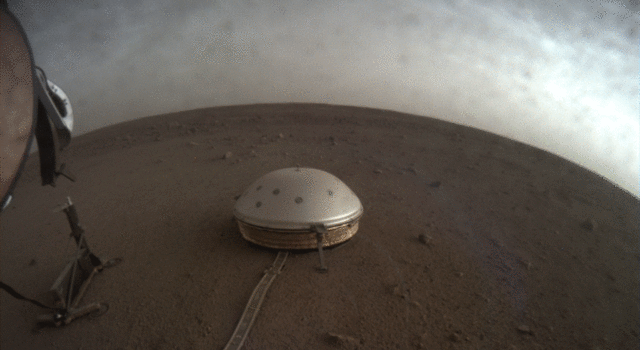Blogs | Dawn Journal | April 30, 2013
To Be in the Right Place, Dawn Catches Up With Time
Dear Dawnscerning Readers,
Nearly three times as far from Earth as the sun is, the Dawn spacecraft is making very good progress on its ambitious trek from Vesta to Ceres. After a spectacular adventure at the second most massive resident of the main asteroid belt between Mars and Jupiter, Dawn used its extraordinary ion propulsion system to leave it behind and undertake the long journey to a dwarf planet.
Ceres orbits the sun outside Vesta's orbit, yet Dawn is now closer to the sun than both of these alien worlds. How can it be that as the probe climbs from one to the other, it seems to be falling inward? Perhaps the answer lies in the text below; let's venture on and find out!
On Halloween we discussed why Dawn is heading in toward the sun, but this question is different. Vesta also is getting closer to the sun, but what's of interest now is that Dawn, despite its more remote destination, has been approaching the sun more quickly. That earlier log stands out as the best one ever written on this exciting mission in the entire history of October 2012, but if you prefer not to visit it now, we can summarize here the explanation for the spacecraft moving toward the sun. Like all members of the sun's entourage, Vesta and Ceres follow elliptical orbits, their distances from the master of the solar system growing and shrinking as they loop around it. Even Earth's orbit, although nearly round, certainly is not perfectly circular. Our planet is a little closer to the sun in the northern hemisphere winter (southern hemisphere summer) than it is in the summer (southern hemisphere winter). Dawn's orbit is elliptical as well, so it naturally moves nearer to the sun sometimes, and now is such a time. But that does not address why it is currently closer to the sun than Vesta, even though it is seeking out the more distant Ceres.
Because it will orbit Ceres, and not simply fly past it (which would be significantly easier but less valuable), Dawn must make its own orbit around the sun be identical to its target's. But that is not the entire story. After spending 14 months orbiting Vesta, Dawn's challenge is more than to change the shape of its orbit to match Ceres's. The spacecraft also must be at the same place in Ceres's heliocentric orbit that Ceres itself is.
It would not be very rewarding to follow the same looping path around the sun but always be somewhere else on that path. You can visualize this if you have one of the many defective -- er, exotic clocks from the Dawn gift shop on your planet that have two minute hands. If the clock starts with one hand pointed at 12 and another pointed at 1, they will take the same repetitive route, but neither hand will ever catch up with the other. For Dawn's goal of exploring Ceres, this would not prove satisfying. Therefore, part of the objective of the ion thrusting is to ensure the spacecraft arrives not only on the same heliocentric course as Ceres but is there when Ceres is also.
This is a problem familiar to all readers who have maneuvered in orbit, where the principles of orbital mechanics are the rules of the road. To solve it, we rely on one of the laws that we have addressed many times in these logs: objects in a lower orbit travel faster. We described this in more detail in February, and we can recall the essential idea here. The gravitational attraction of any body, whether it is the sun, Earth, a black hole, or anything else, is greater at shorter ranges. So to balance that strong inward pull, an orbiter is compelled to race around quickly. At higher orbits, where gravity is weaker, a more leisurely orbital pace suffices.
We can take advantage of this characteristic of orbits. If we drop to a slightly lower orbit, we travel along more swiftly. That is precisely what Dawn needs to do in order to ensure that when it finishes expanding and tilting its orbit in 2015 so that it is the same as Ceres's, it winds up at the same location as its target. This would be like speeding up the minute hand that had begun at the 12, allowing it to catch up with the hand that would otherwise always be leading it.
Dawn's orbital maneuvering is a little bit more complicated than that of clock hands, but thanks to the ingenuity and creativity of the operations team and the unique capability of its ion propulsion system, the interplanetary ship is sailing on a carefully plotted course to its next celestial port. As soon as it departed from Vesta's gravitational embrace in September, it slipped in closer to the sun. Today, Vesta is 2.53 AU from the sun, and Dawn is 2.51 AU, so the spacecraft is three million kilometers (1.9 million miles) nearer to the sun. (Dawn is farther from Vesta than that, because they are not aligned with the sun. The spacecraft has also moved ahead of the rocky behemoth.)
Of course, eventually Dawn will climb to higher altitudes from the sun than Vesta, because its destination lies beyond. As they progress on their own independent orbits, with Dawn constantly reshaping its, they will be at the same solar distance on July 31, 2013. After that, the robotic explorer will never again be as close to the sun as Vesta. By then, they will be 18 million kilometers (11 million miles) apart. But they will always be connected. Dawn was Earth's first probe to take up residence in the main asteroid belt, and Vesta was its first target. The exotic world had beckoned to humankind for over two centuries before the spacecraft obtained its richly detailed view. Now what was little more than an indistinct point of light is known as a complex and fascinating place with a unique character. And as it follows its repetitive orbit around the sun, its erstwhile companion seeks to reveal the secrets of another extraterrestrial enigma, Ceres. Great treasures await Dawn as it patiently continues its extraordinary deep-space expedition.
Dawn is 10 million kilometers (6.3 million miles) from Vesta and 56 million kilometers (35 million miles) from Ceres. It is also 2.99 AU (448 million kilometers or 278 million miles) from Earth, or 1,215 times as far as the moon and 2.97 times as far as the sun today. Radio signals, traveling at the universal limit of the speed of light, take 50 minutes to make the round trip.
Dr. Marc D. Rayman
7:00 p.m. PDT April 30, 2013
TAGS:DAWN, CERES, VESTA, DWARF PLANETS, SOLAR SYSTEM, MISSION, SPACECRAFT







